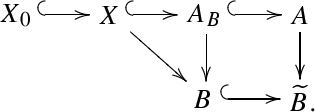1 Erratum to: Math. Ann. (2010) 346:545–569 DOI 10.1007/s00208-009-0397-6
Fabian Langholf and Pierrick Bousseau pointed out that Lemma 2.2 in the Original publication requires \(X\) and \(A\) to be flat over the base \(B\). For instance the sequence (2.4) in Proof of Lemma 2.2 is not in general exact without this assumption.
After inserting the assumption of flatness of \(X_0,\,X\) and \(A\) over \(B\), Sects. 2 and 3 can be left unchanged. Applied to \(B=\mathrm{Spec}\,k\) with \(k\) a field, this is enough to produce virtual cycles in Sect. 4. But to prove their deformation invariance, we need to work with a relative moduli space \(\mathcal M/B\) whose flatness over \(B\) cannot be assumed. In fact, in the Behrend–Fantechi relative obstruction theory of Sect. 4, flatness of \(X\) and \(X_0\) over the base does not hold in general, so we prefer to proceed as follows.Footnote 1
-
Throughout Sects. 2 and 3 we set \(B=\mathrm{Spec}\,k\) with \(k\) a field. All necessary flatness assumptions are then automatic. Thus, without further modifications, the paper defines the absolute, rather than relative, truncated Atiyah class \(A(E_0)\) and the absolute truncated Kodaira–Spencer class \(\kappa (X_0/X)\). Then Corollary 3.4 proves that their product
$$\begin{aligned} \left( \mathrm{id}_{E_0}\otimes \kappa (X_0/X)\right) \circ A(E_0)\,\in \,\mathrm{Ext}^2_{X_0}\left( E_0,E_0\otimes I\right) \end{aligned}$$(1.1)is the obstruction to deforming a perfect complex \(E_0\) from \(X_0\) to its thickening \(X\).
-
To define relative versions of these objects we first need to define the relative truncated cotangent complex. To do this we embed \(X_0\subset X\) as follows:

Here \(\widetilde{B}\) and \(A\rightarrow \widetilde{B}\) are both smooth, and the square is Cartesian (i.e. \(A_B=A\times _B\widetilde{B}\)). Thus \(A\) and \(A_B\rightarrow B\) are also smooth. Letting \(J_{0B}\) denote the ideal sheaf of \(X_0\subset A_B\) we get the natural commutative diagram

The vertical 2-complex on the left is \(\mathbb {L}_{X_0}\) and we define \(\mathbb {L}_{X_0/B}\) to be the vertical 2-term complex on the right, giving the projection
$$\begin{aligned} \mathbb {L}_{X_0}\rightarrow \mathbb {L}_{X_0/B}. \end{aligned}$$(1.2)Applied to the Atiyah class \(A(E_0)\in \mathrm{Ext}^1_{X_0}(E_0,E_0\otimes \mathbb {L}_{X_0})\) this defines a relative Atiyah class \(A(E_0/B)\in \mathrm{Ext}^1_{X_0}(E_0,E_0\otimes \mathbb {L}_{X_0/B})\). The natural map \(J_0/J_0^2\rightarrow I\) factors through \(J_{0B}/J_{0B}^2\rightarrow I\). The former defines the Kodaira–Spencer class \(\kappa (X_0/X):\mathbb {L}_{X_0}\rightarrow I[1]\), so using the latter to define the relative Kodaira–Spencer class \(\kappa (X_0/X/B):\mathbb {L}_{X_0/B}\rightarrow I[1]\) we see they commute with the projection (1.2). Thus the product of the relative Atiyah class and the relative Kodaira–Spencer class equals the product (1.1) of their absolute versions:
$$\begin{aligned} \left( \mathrm{id}_{E_0}\!\otimes \!\kappa (X_0/X/B)\right) \!\circ \! A(E_0/B) \!=\!\left( \mathrm{id}_{E_0}\!\otimes \!\kappa (X_0/X)\right) \!\circ \! A(E_0) \!\in \! \mathrm{Ext}^2_{X_0}\left( E_0,E_0\!\otimes \! I\right) \!.\nonumber \\ \end{aligned}$$(1.3) -
Finally, in Sect. 4, we project the Atiyah class \(A(\mathbb {E})\in \mathrm{Ext}^1_{X\times _B{\mathcal {M}}} (\mathbb {E},\mathbb {E}\otimes \mathbb {L}_{X\times _B{\mathcal {M}}})\) of the universal sheaf \(\mathbb {E}\) by \(\mathbb {L}_{X\times _B{\mathcal {M}}}\rightarrow \mathbb {L}_{X\times _B{\mathcal {M}}/X}=\pi _{\mathcal {M}}^*\mathbb {L}_{{\mathcal {M}}/B}\) to give Eq. 4.2:

The proof that this is a perfect obstruction theory proceeds without change using the relative classes defined above. As in Eq. 4.5 we end up with an obstruction class expressed as a product of a relative truncated Atiyah class \(A(\bar{f}^*\mathbb {E}/X)\) and a relative truncated Kodaira–Spencer class \(\kappa (X\times _BS_0/X\times _BS/X)=\bar{\pi }^*\kappa (S_0/S/B)\).
This equals the product of the corresponding absolute classes by (1.3). By Corollary 3.4, this equals the obstruction to deforming \(\bar{f}^*\mathbb {E}\) from \(X\times _BS_0\) to \(X\times _BS\). Since such deformations are in one-to-one correspondence with extensions from \(S_0\) to \(S\) of the \(B\)-map \(f\), the proof concludes just as in Original publication.
Notes
Alternatively the reader could consult arXiv:0805.3527v2, which is a corrected version of the paper in which these modifications have been enacted.
Author information
Authors and Affiliations
Corresponding author
Additional information
The online version of the original article can be found under doi:10.1007/s00208-009-0397-6.
Rights and permissions
About this article
Cite this article
Huybrechts, D., Thomas, R.P. Erratum to: Deformation-obstruction theory for complexes via Atiyah and Kodaira–Spencer classes. Math. Ann. 358, 561–563 (2014). https://doi.org/10.1007/s00208-013-0999-x
Published:
Issue Date:
DOI: https://doi.org/10.1007/s00208-013-0999-x




